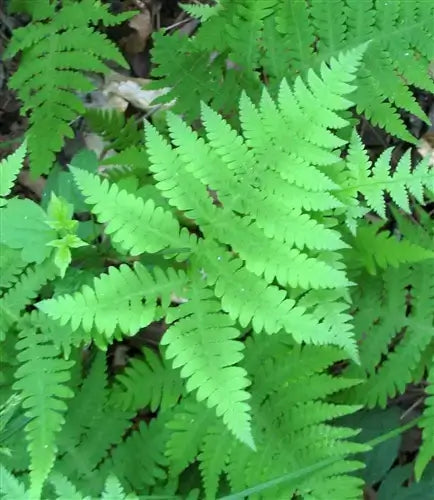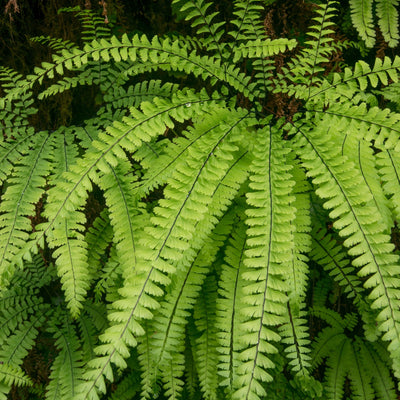The fern fronds are whimsical, making them an excellent plant to fill in the spaces around your home. The fern plants look stunning as ground covers or an ornamental focal point in the garden.
You've probably seen native ferns grow in the forests' organic matter. There are various ferns, including Wood fern (Dryopteris) and Polypodium.
Many ferns thrive in the shade due to the soil's richness which remains moist longer than in the sun. Ferns are often considered plants that prefer shade. However, many sun-loving ferns thrive in gardens flooded with sunlight. The key is to supply them with moist soil to keep them from drying out.
Here are 5 fern types that will happily live in sunny areas of your garden:
1. Royal Fern
Osmunda Regalis is among the most water-loving shade perennials. It is a considerable size and is adorned with gorgeous green leaves. It is a fan of semi-shaded areas and can be found amid trees, shrubs, or tall plants. It is best suited for USDA zones 3-8.
The Royal fern is a tough ornamental plant tolerant of temperatures, cold, light flooding, heat and droughts. Royal ferns are impressive at maturity, between three and six feet tall and up to eight feet wide. They feature substantial broad, feather-shaped fringes that have a vibrant deep green. The fronds have two rows of smaller, oval leaves with gently rounded edges. The ferns usually develop upright.
However, they can slide down or be bent over due to the fronds' stress as they age. The Royal fern reproduces by the spore-bearing structure located on the fronds' bottom. They don't require you to fertilize them to help them multiply. Royal ferns like moist, shaded regions. They are tolerant of specific sunshine, but they prefer filtered or dappled sunlight. They thrive in wetlands, bogs, gardens, or near streams or ponds.
2. Bracken Fern
Pteridium Aquilinum is a substantial evergreen fern, an indigenous species in many regions of the globe, including Europe, Asia, and North America. They're a stunning shade of green that will bring life to any shaded space. They are thriving in USDA zones 3 through 11.
They thrive with little to no maintenance and require a shaded spot with a thick, woody, organic material similar to what is found in its native forests and damp but not excessively moist soil. Bracken fern reproduces without the need for care. It reproduces through tiny spores, like dust-like structures that separate from the underside of fronds.
It is the reason this fern is such an extremely popular groundcover. It is famous for its vast, triangular leaves at least three feet high.
Various tiny leaflets in feathery patterns make up the stunning bright green frosts. The fronds typically measure 2 to 3 feet long and between one and two feet wide. The stem of the bracken fern is usually black or dark brown and could be slightly smooth or ridged. The roots of this plant may also be quite large. The Bracken Fern is an incredibly distinctive plant that can discern its presence in the wild due to its triangular fronds resembling a shuttlecock's shape.
3. Maidenhair Fern
Adiantum Pedatum is a sturdy perennial that can make an impressive appearance in the shade of the garden or natural wooded area. It is a fan of the sun, filtered approximately six hours daily. It is adjusted to USDA zones of hardiness for plants 3-8. Maidenhair fern is a stunning species native to two continents: North America in the United States and Canada and Asia in the Himalayan region.
This fern is low-maintenance and easy-growing which makes it the most sought-after shade plant, perfect for shaded border rocks and slopes of ponds.
The Maidenhair fern is also great to plant on sloped hills since they're much easier to cultivate than grass. The appearance of Maidenhair ferns could be deceiving. They have small and fan-shaped leaflets made of a single frond creating an appearance similar to hair.
Leaflets have a vibrant spring green color, with contrasts from the darker veins. Although it has a delicate appearance, these ferns are hardy. They're resistant to cold, disease, and insects.
The Maidenhair ferns require little care and all they need is a semi-shaded space and fertile soil. Adding mulch made of hardwood and earthworm castings will help retain moisture and give your ferns great nutritional support.
4. Cinnamon Fern
An Eastern North American native, Osmunda Cinnamomea is a perennial fern. With its stunning greenery and low maintenance, this plant is an excellent choice. It thrives in USDA zones 4 to 9 in a semi-to-full shade-growing setting.
They are great as ground cover for flower beds, as an accent plant, for foundation plantings, or for ornamental species. The common name comes due to the color of its reddish-brown fronds, which look like cinnamon sticks in form and color. It has enormous feathery fronds that can reach as high as four feet.
The fronds of the Cinnamon fern consist of various small leaflets, forming an ethereal pattern. The leaflets typically are bright green and shiny. The stems of the Cinnamon fern can be light brown or rusty and are sometimes slightly smooth or ridged. The roots are robust and can easily support the massive fronds. They are durable, resistant to insects and diseases, and do well in extreme weather.
5. Ostrich fern
Matteuccia Struthiopteris is a massive and dazzling perennial fern with beautiful, plume-like fronds.
Ostrich fern new growth begins to emerge in the springtime, the newly formed fronds are covered in an orange-colored fuzzy covering called the “crown”. The Ostrich fern gets its name from the open plumes that resemble ostrich feathers.
Maintaining and planting an ostrich fern can be simple. It will adjust to the early morning sun, but it will not tolerate the afternoon sunlight. It prefers fertile, moist soil that has rapid and efficient drainage, so its roots don’t sit in water for too long.
Selecting the right ferns for your garden means considering a few factors, including heat tolerance, maintenance, and aesthetic appeal. From the impressive size and water-loving nature of the Royal Fern to the low-maintenance characteristics of the Bracken Fern, each type brings its unique features. Whether used as ground covers, ornamental focal points, or accents in shaded areas, these ferns contribute to the beauty and vibrancy of any garden space.

